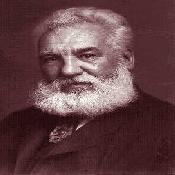Alexander Graham Bell Biography
Inventor of Telephone, Metal Detector, Audiometer, Metal Jacket And Hydrofoils
Posted on September 21, 2009 by Jamie Slaughter, with 32767 views

Alexander Graham Bell first invented the telephone at the age of 29, in 1877. The following year, the Bell Telephone Company was established, during which time he married Mabel Hubbard and setting off on a honeymoon across Europe for an entire year.
Alexander Graham Bell's fame is attached to the success of the telephone, but in fact bell embarked upon several other projects. He remained an ambitious and creative man throughout his life, during which he would continue to learn, create and challenge himself to improve the modern world. Bell engaged in many different scientific studies including kites, airplanes, tetrahedral structures, sheep-breeding, desalinization, water distillation, hydrofoils and artificial respiration, as documented in his various journals and logbooks.
The Invention of the telephone empowered Bell, in terms of financial security, which allowed him to devote himself to developing his other ideas and interests. In 1881, Bell won France's Volta prize of $10,000 which he used to et up the Volta Laboratory in Washington, D.C. This is where Bell teamed up with Chichester Bell and Charles Sumner Tainter, to produce a marketable version of the Phonograph, first thought up by Thomas Edison. A secondary laboratory was set up in 1885, at Beinn Bhreagh, near Baddeck, where he brought together an intelligent young team to follow new ideas and concepts.
The photophone was the first invention created by Bell after the telephone, which allowed sound to be transmitted via a beam of light. Charles Sumner Tainter and Bell himself developed the photophone using sensitive selenium crystal and a mirror which vibrated in reply to sound. The first successfully transmitted photophone message was sent in 1881 over a distance of 200 yards. Bell hailed the photophone as "the greatest invention I have ever made; greater than the telephone." This invention is the fundamental principle which modern day lasers and fiber optics rely on, although many other principles had to be recognised before these were brought into effect.
Alexander Graham Bell's interest in heredity, led him to explore, first of all the deaf followed by sheep born with genetic abnormalities. He conducted various sheep-breeding experiments in which he strived to increase the number of twin and triplet births. Bell also created an electromagnetic device to detect a bullet. following President Garfield being shot by an assassin and having the bullet lodged inside him. He continued to work on this and thus invented the telephone probe, which would make a telephone receiver click when it connected with metal.
Bell's son, Edward, died due to respiratory problems which inspired Bell to invent a metal vacuum jacket which assists breathing. He also invented an audiometer which detected small hearing problems, conduced various experiments relating to energy recycling and substitute fuels, and attempts of separating salt from seawater.
The bulk of Bell's time was then spent exclusively on flight, as Bell enjoyed a challenge. The 1890's saw Bell develop a keen interest in propellers and kites, which led him to create a new kite design, based on a tetrahedron. In 1907, Bell established the Aerial Experiment Association with Glenn Curtiss, William "Casey" Baldwin, Thomas Selfridge and J.A.D. McCurdy, four young engineers with a passion for creating airborne transport. It took the group 2 years to create four powered aircraft, the Silver Dart being the stand-out project which made it's first flight in Canada on February 23rd, 1909.
Bell ended his career by concentrating on hydrofoils, looking to improve their performance, and in 1919, himself and Casey Baldwin built a hydrofoil which set a water-speed record which would not be beat for 44 years.
Shortly before Bell died, he told a reporter, "There cannot be mental atrophy in any person who continues to observe, to remember what he observes, and to seek answers for his unceasing how's and why's about things."
